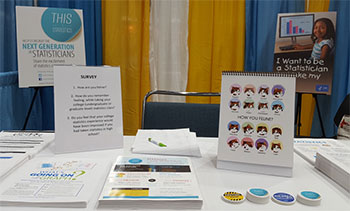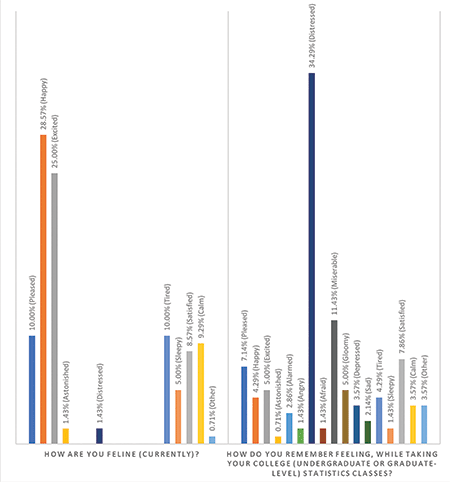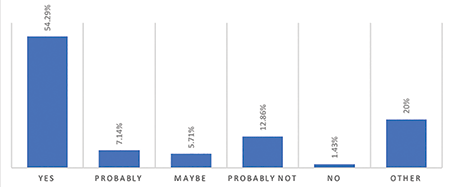Study Provides Insight into Emotions, Perspectives of School Counselors
Anna Yu Lee

The ASA booth at the American School Counselor’s Association conference offers promotional literature, infographics, survey questions, and a feline faces chart.
The American Statistical Association hosted a booth at the annual American School Counselor’s Association (ASCA) conference in Los Angeles July 14–17, 2018, to promote the practice and profession of statistics among a group of approximately 3,000 K–12 school counseling professionals.
The booth was staffed by three ASA representatives who provided visitors with recent ASA publications and resources. Distributed materials provided information about the rising importance of statistics as a career option, a list of undergraduate and graduate majors requiring coursework in statistics, and a list of career fields available to students with statistical education/training. Counselors were offered follow-up visits and consultations with ASA representatives.
During the first two days of the conference, ASA representatives generated booth traffic and initiated conversations with apparent school counselors (most of whom were identified by their lanyards) by pointing to a feline faces chart and asking potential participants, “How are you feline?”
The feline faces chart is a visual tool sporting 16 faces of cats with various facial expressions and captioned emotions. It can be used alongside open-ended or multiple-choice questions as a tool for initiating and facilitating communication regarding emotions and mental health.
The wording of the survey question was a homophonous play on the words “feeling” and “feline,” as well as a play on the use of cat expressions in the visual.
If school counselors asked for clarification of the meaning of this question, they were told the question was intended to assess what emotion they were feeling most at that particular moment.
School counselors who responded to the question were then asked if they would be willing to participate in a survey that would include an additional two questions. If school counselors answered the first question but declined to participate in the remainder of the survey, their answers to the first question were not recorded.
The second question in this survey was, “How do you remember feeling while taking your college undergraduate or graduate-level statistics classes?” Responses to questions 1 and 2 were collected as follows:
Quantitative responses to questions 1–3 are described in figures 1–2.

Figure 1. Current emotions versus recalled emotive experiences of studying statistics in undergraduate or graduate university, among 140 school counselors

Figure 2. Responses to question, “If you had taken a statistics class in high school do you think that your college experience in statistics would have been any better than what it was?”
Responses indicated the majority of school counselors recalled experiences of studying statistics in college that they described with words associated with more unpleasant affect (i.e., alarm, anger, distress, fear, misery, gloom, depression, sadness, and tiredness; n = 93; 66%). By contrast, a majority of counselors reported same-day (i.e., current) emotions that appeared to be associated with more pleasant affect (i.e., pleasure, happiness, excitement, astonishment, sleepiness, satisfaction, and calm; n = 123; 88%).
Both recalled emotive experiences and current emotional states appeared approximately balanced on dimensions of arousal: recalled experiences associated with lower arousal (i.e., pleasure, misery, gloom, depression, sadness, tiredness, sleepiness, satisfaction, and calm, n = 65, 46%); recalled experiences associated with higher arousal (i.e., happiness, excitement, astonishment, alarm, anger, distress, fear, n = 70, 50%); current emotions associated with lower arousal (n = 60, 43%); current experiences associated with higher arousal (i.e., n = 79, 56%).
A majority of counselors indicated they felt having taken statistics in high school would have improved their experiences with taking college statistics by answering “yes” to the question, “Do you feel that your college statistics experience would have been improved if you had taken statistics in high school?” (n = 76; 54%).
This experience provided evidence for the following:
- A preponderance of negative personal memories associated with studying statistics in college among school counselors
- Perceived benefits of prior K–12 statistical education on subsequent undergraduate- and graduate-level statistics studies among school counselors
- Potential benefits of including the feline faces chart in participant recruitment and data collection efforts
The responses of the participants in this study were informative, as they contextualized and provided insight into the emotions and perspectives of school counselors—a group particularly positioned for shaping the content and direction of early education curricula.

















